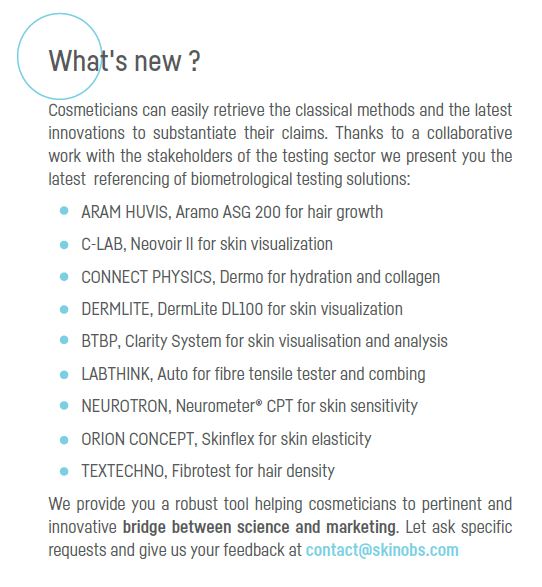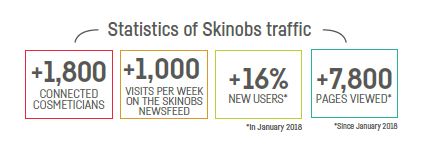ZOOM#8: testing trends in cosmetics, Sensory Analysis, Keynotes of the ISBS congress
4 July 2018
We are delighted to share with you our latest Newsletter: ZOOM#8, special edition for the summer.
The beginning of the year was a period of many events regarding clinical testing.
“Boost Your Test” at in-cosmetics was a unique opportunity to meet international evaluation managers. We have answered questions about Microbiote, Anti-pollution and Anti-ageing assessments.
ISBS conferences, International Society for Biophysics and Imaging , in San Diego was focus on the latest Skin Bioengineering research. Now it’s time to take stock of the main trends and present you the lastest innovations of our partners: Cerco, Cosmepar, Dermscan, Dermatec, Eotech, Eurofins, Intertek, Phylogene, Orion, JS Hamilton, Varenne Technologies, Zurko research and Lipotype.
Upload the complete Newsletter: Skinobs ZOOM#8 Sensory & ISBS
We will have special focus on the latest devices referencing in the plaform:
Then, the news of our partners
- An innovative predictive tool for substantiation, LC-MS/MS proteomics and CoravalidTM, by Phylogene
- Intertek acquires a new device: the C-Cube
- Find tomorrow new textures thanks to sensory analysis by Eurofins!
- The different methodologies of sensory analysis by the Cerco
- Sensorial analysis: a major asset of the Dermscan Group
- Lipid analysis for skin penetration properties of saturated phospholipids by Lipotype
- Antiperspirants and deodorants evaluation by Hamilton J.S Poland
- Eotech celebrates its 25 anniversary with the Evaskin
- Cosmepar the complementary expertise of microbiology, tolerance and efficacy evaluations
- Dermatec celebrated the inauguration of its new lab centre
- An innovative device to objectivate skin ageing by Varenne Technologies
- SkinFlexTM – OrionTechnoLab, France
- Zurko Research evaluates deodorants and antiperspirants efficacy
And the lastest statistics of the platform audience
Small extractof the Sensory analysis
SENSORY ANALYSIS, TheSCIENCE BEYOND THE PERCEPTIONS
Beyond safety and efficiency characteristics, the sensory analysis is a major criterion of the personal care product objectivation by describing, discriminating and comparing them.
Everyone knows that organoleptic properties and consumer insights using direct life experiences are part of the perception of the efficacy by the consumers.
The sensory analysis using the human senses are scientific studies based on experimental design and statistical analysis. They concern all types of products and are generally conducted following standardised practices and normative process covering the 4 phases of the cosmetics use: the appearance, the pickup, the application and on final touch.
The sensory analyses use two types of panels:
- The expert ones: trained assessors who measure the various characteristics of the product or
- The naïve ones: subjects who test the products and give their opinion on its characteristics.
How to objectivate the real and perceived efficacy?
Sensory analyses are tailored protocols to be deeply defined with your testing suppliers in function of the
targeted countries. It requires specific equipment such as specialised test rooms (Afnor NFV 09105) with individual cabinets including : fizz network, sink, mirror, standardised daylight neon… The protocols include discriminative tests, descriptive tests for organoleptic properties (appearance, odour, texture) and for perceptions (liking, insights, acceptability, perceived efficacy).
It may be subdivided into three sections:
- Analytical testing by the expert panel:
evaluation of the objective facts of the products for the discrimination testing and the descriptive profiling: hedonic test, Product characterisation, Sniff tests, Organoleptic properties: appearance, the odour, the texture. The panellists rate the intensity of each descriptor (previously defined) answering a questionnaire.
- Affective testing: evaluation of the subjective facts such as preferences.
- Perception analysis: evaluation of the biochemical and psychological aspects of the holistic sensation focused on the overall appearance of the product.
Other analyses also enable the sensory evaluation by naïve panels:
- Consumer testing including large (50 or more) panels. It obtains subjective data, or how well products are likely to be accepted. It is simple comparative or more complex questioning.
- Focus group testing with small subject number obtain qualitative and deep insight mapping.
The sensory profile with expert panel is useful for all phases of the products development and represents a sensitive tool which can be compared with instrumental measurement. It is very helpful to optimise links between formulation and worldwide product perception.
…./…
See you at the IFSCC Congress in München!
Happy reading and great Summer!
Anne Charpentier
Founder










 Follow us on Linkedin!
Follow us on Linkedin!
You must be logged in to post a comment.